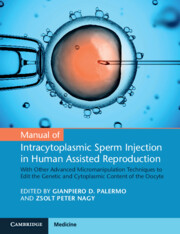 Manual of Intracytoplasmic Sperm Injection in Human Assisted Reproduction
Manual of Intracytoplasmic Sperm Injection in Human Assisted Reproduction Book contents
- Manual of Intracytoplasmic Sperm Injection in Human Assisted Reproduction
- Manual of Intracytoplasmic Sperm Injection in Human Assisted Reproduction
- Copyright page
- Contents
- Contributors
- Foreword
- Chapter 1 In Vitro Fertilization and Micromanipulation
- Chapter 2 Development of ICSI in Human Assisted Reproduction
- Chapter 3 Current ICSI Applications and Clinical Outcomes
- Chapter 4 Rescue ICSI of IVF Failed-Fertilized Oocytes
- Chapter 5 Morphological Sperm Selection Before ICSI
- Chapter 6 Laser-Assisted ICSI
- Chapter 7 Piezo: The Add-On to Standardize ICSI Procedure
- Chapter 8 Artificial Oocyte Activation After ICSI
- Chapter 9 Health of Children Born after Intracytoplasmic Sperm Injections (ICSI)
- Chapter 10 Examining the Safety of ICSI Using Animal Models
- Chapter 11 Cellular and Molecular Events after ICSI in Clinically Relevant Animal Models
- Chapter 12 Micromanipulation, Micro-Injection Microscopes and Systems for ICSI
- Chapter 13 Automation Techniques and Systems for ICSI
- Chapter 14 Germline Nuclear Transfer Technology to Overcome Mitochondrial Diseases and Female Infertility
- Chapter 15 Nuclear Transfer Technology and Its Use in Reproductive Medicine
- Chapter 16 The Prospects of Infertility Treatment Using “Artificial” Eggs
- Index
- Plate Section (PDF Only)
- References
Chapter 6 - Laser-Assisted ICSI
Published online by Cambridge University Press: 02 December 2021
- Manual of Intracytoplasmic Sperm Injection in Human Assisted Reproduction
- Manual of Intracytoplasmic Sperm Injection in Human Assisted Reproduction
- Copyright page
- Contents
- Contributors
- Foreword
- Chapter 1 In Vitro Fertilization and Micromanipulation
- Chapter 2 Development of ICSI in Human Assisted Reproduction
- Chapter 3 Current ICSI Applications and Clinical Outcomes
- Chapter 4 Rescue ICSI of IVF Failed-Fertilized Oocytes
- Chapter 5 Morphological Sperm Selection Before ICSI
- Chapter 6 Laser-Assisted ICSI
- Chapter 7 Piezo: The Add-On to Standardize ICSI Procedure
- Chapter 8 Artificial Oocyte Activation After ICSI
- Chapter 9 Health of Children Born after Intracytoplasmic Sperm Injections (ICSI)
- Chapter 10 Examining the Safety of ICSI Using Animal Models
- Chapter 11 Cellular and Molecular Events after ICSI in Clinically Relevant Animal Models
- Chapter 12 Micromanipulation, Micro-Injection Microscopes and Systems for ICSI
- Chapter 13 Automation Techniques and Systems for ICSI
- Chapter 14 Germline Nuclear Transfer Technology to Overcome Mitochondrial Diseases and Female Infertility
- Chapter 15 Nuclear Transfer Technology and Its Use in Reproductive Medicine
- Chapter 16 The Prospects of Infertility Treatment Using “Artificial” Eggs
- Index
- Plate Section (PDF Only)
- References
Summary
ICSI is a well-established insemination method in IVF due to its overall efficacy and reliability, even when severe male factor is not the main cause of infertility. Although conventional-ICSI provides high fertilization rate, it suffers from some technical drawbacks. Sudden or delayed oocyte degeneration may occur after ICSI even when performed by experienced embryologist and extreme care is applied during the injection phase. Preliminary results from studies conducted in early 2000s suggest that laser-assisted micro-drilling of the zona pellucida before injection (LA-ICSI) may be useful to make ICSI more successful when inseminating oocytes more prone to fertilization failure. Although this condition does not affect many couples, in case of degeneration of all the injected oocytes the IVF cycle must be cancelled. In these cases, LA-ICSI becomes a valuable option that deserves consideration.
Keywords
- Type
- Chapter
- Information
- Manual of Intracytoplasmic Sperm Injection in Human Assisted ReproductionWith Other Advanced Micromanipulation Techniques to Edit the Genetic and Cytoplasmic Content of the Oocyte, pp. 59 - 65Publisher: Cambridge University PressPrint publication year: 2021


